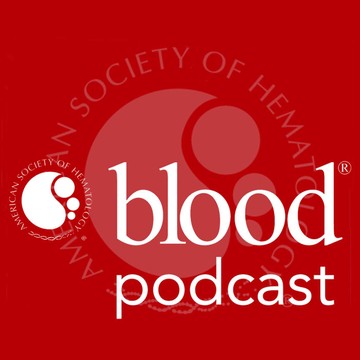

Blood Podcast
American Society of Hematology
The Blood Podcast summarizes content recently published in Blood, the most cited peer-reviewed publication in the field of hematology.
Episodes
Mentioned books

Jul 3, 2025 • 19min
A novel mouse model of sickle cell SC disease; multiple myeloma induction therapy with isatuximab, carfilzomib, lenalidomide, and dexamethasone; and splicing factor mutations in myelodysplastic syndromes
Discover the groundbreaking mouse model mimicking human sickle cell SC disease, providing insights into treatment possibilities. Explore the promising results of a quadruplet therapy for multiple myeloma, combining isatuximab and others. Unearth the connection between splicing factor mutations and the clonal dynamics of myelodysplastic syndromes, revealing new potential therapeutic approaches. This week’s discussions dive deep into innovative therapies reshaping hematological disease management.

Jun 26, 2025 • 18min
An AI model for transplant risk in myelofibrosis; preventing priapism in men with sickle cell anemia; hallmarks of T cell exhaustion absent in newly diagnosed MM
Discover how AI is revolutionizing transplant risk assessment in myelofibrosis, identifying patients with poor outcomes. Explore a feasibility study on preventing priapism in men with sickle cell anemia, showcasing promising adherence to new therapies. Finally, delve into groundbreaking findings that reveal the absence of T-cell exhaustion in newly diagnosed multiple myeloma, challenging existing beliefs and opening doors for innovative treatment strategies.

Jun 23, 2025 • 20min
Social determinants of health and access to allogeneic hematopoietic cell transplantation, megakaryocyte growth factor receptor-based pretransplant conditioning for ex vivo autologous gene therapy, and novel protein biomarkers for risk stratification in a
Discover how social factors like income and education impact access to critical treatments for acute myeloid leukemia. Dive into groundbreaking advances in ex vivo gene therapy aimed at inherited blood disorders. Learn about the significance of inflammatory biomarkers, particularly the soluble oncostatin M receptor, in predicting patient survival rates. The discussion emphasizes the need for improved support systems and innovative therapies to enhance outcomes for those affected by these conditions.

Jun 19, 2025 • 41min
Aggressive non-Hodgkin lymphoma: defining and managing high-risk subsets
Dr. Mark Roschewski, a clinical investigator at the National Cancer Institute, Dr. Grzegorz Nowakowski from Mayo Clinic, and Dr. Neha Mehta-Shah, an associate professor at Washington University, discuss aggressive non-Hodgkin lymphoma. They highlight the importance of identifying high-risk patients for tailored treatments. The conversation delves into the unique challenges of lymphomas in immune-privileged sites and innovative therapies like BTK inhibitors. They also touch on new options like Polar-RCHIP and the promise of circulating tumor DNA in clinical trials.

Jun 12, 2025 • 21min
A key role for T-cell TET3 in chronic GVHD; a BTK inhibitor for ITP; co-inhibition of pre-TCR and IL-7R pathways in a T-ALL patient subset
Discover the pivotal role of TET3 in chronic GVHD and its potential as a therapeutic target to combat lung fibrosis. Learn about the promising results of rilzabrutinib, a BTK inhibitor, showing significant platelet responses for those suffering from immune thrombocytopenia. Finally, dive into the complexities of T-cell acute lymphoblastic leukemia and how co-inhibition strategies for pre-TCR and IL-7 pathways may open new avenues for treatment. It's a compelling look into groundbreaking research and innovative approaches in hematology.

Jun 10, 2025 • 10min
Special Episode: Eliminating the Need for Sequential Confirmation of Response in Multiple Myeloma
Dr. Shaji Kumar, a Mayo Clinic expert and senior author on a pivotal Blood Journal article, discusses groundbreaking findings in multiple myeloma treatment. He reveals that using two simultaneous blood markers for disease progression is 98% accurate, compared to only 82% for sequential methods. This innovative approach could simplify patient assessments, reduce the need for multiple blood draws, and potentially alter international response criteria. Tune in to hear how these changes promise to enhance clinical trials and streamline myeloma management.

Jun 5, 2025 • 17min
How I Treat Series on Geriatric Hematology
Dr. Patrick Foy, a consultative hematologist at the Medical College of Wisconsin, sheds light on the complexities of geriatric hematology. He discusses diagnosing and treating thrombocytopenia in older patients, emphasizing polypharmacy and chronic conditions. The conversation highlights the challenges of anticoagulant management, advocating for careful medication assessments. Additionally, Foy stresses the importance of collaboration among healthcare providers and involving patients in treatment decisions to enhance care for the aging population.

Jun 5, 2025 • 16min
Single cell multi-omic analysis of leukemia stem cells, cyclophosphamide for non-immune effector cell-associated neurotoxicity, and glycosylation as a mediator of von Willebrand factor clearance
Dive into the fascinating world of leukemia stem cells as researchers use single-cell multi-omics to identify unique subpopulations, paving the way for new treatments. Discover how cyclophosphamide can alleviate non-immune neurotoxicities in CAR T-cell therapy patients, stressing the need for prompt management. Also, explore the intriguing effects of glycosylation on von Willebrand factor half-life, comparing recombinant and plasma-derived options and their impact on future therapies. Science and a glimpse into innovative treatments await!

May 29, 2025 • 20min
New insights on PU.1-mutated agammaglobulinemia; venetoclax-based induction therapy in younger AML patients; the link between ABO Blood groups and risk of future VTE
Discover groundbreaking insights into PU.1-mutated agammaglobulinemia, revealing how genetic mutations affect immune response and infection risks. Learn about the efficacy of venetoclax-based induction therapy in younger AML patients, offering a safer alternative to intensive chemotherapy. Dive into the intriguing connection between ABO blood groups and future venous thromboembolism risk, highlighting the role of an enzyme that influences blood type. These discussions shine a light on innovative treatments and genetic impacts in medicine.

May 22, 2025 • 34min
How I Treat Transfusion Medicine (part 2)
Join Dr. Jeannie Callum, an esteemed adult hematologist and professor, along with Dr. Ron George, a leading anesthesiology professor, as they delve into transfusion medicine's complexities. They discuss innovative strategies for managing major hemorrhage and the importance of individualized treatment protocols. Topics include viscoelastic testing and advancements in fibrinogen therapies. Communication among medical teams emerges as vital for effective care, along with recent improvements in antenatal anemia management that have reduced transfusion needs and enhanced patient outcomes.


